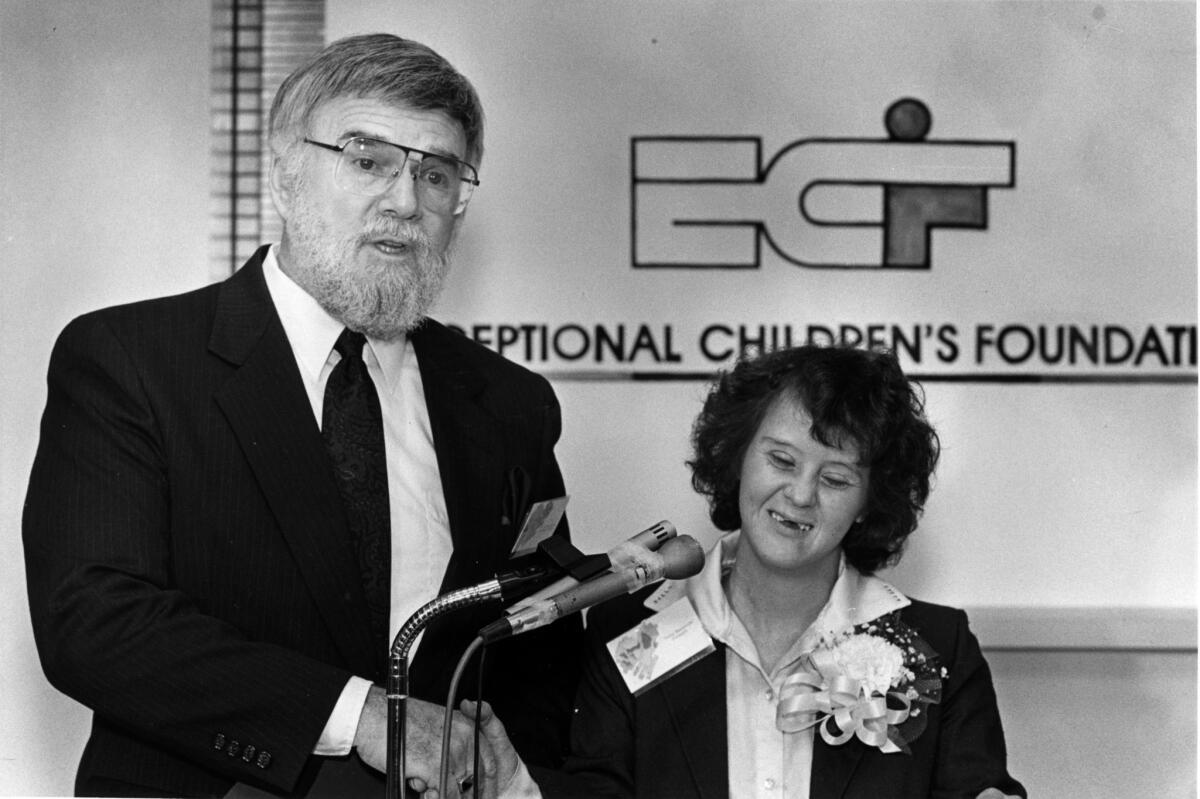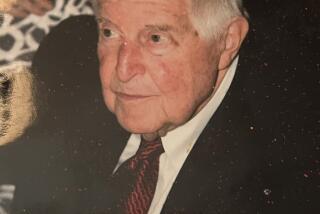Robert Shushan dies at 86; opened doors for the developmentally disabled

Robert Shushan, executive director of the Exceptional Children’s Foundation, celebrates with Terry Westbrook, who was chosen to accept a national award honoring the organization for the developmentally disabled, in 1988.
In 1958, Robert Shushan was a Los Angeles high school teacher with hopes of joining the administrative ranks when his sister disrupted his plans.
She belonged to a grass-roots parents group that wanted to provide an alternative to institutionalization for children like her son, who was born with profound intellectual disabilities. But the group was broke and falling apart. Would Shushan consider taking charge as its first executive director?
He thought he would help out temporarily, but he wound up guiding the Exceptional Children’s Foundation to the forefront of its field over the next 40 years.
Under his leadership, the Culver City-based nonprofit pioneered programs to tap the potential of people who society had largely written off. It is now one of the oldest organizations in the country providing training, jobs and other services to children and adults with Down syndrome and other conditions.
“He was there at the frontier ... a very creative and strong spokesperson for individuals with developmental disabilities,” said Leslie B. Abell, an attorney and past chair of the foundation.
Shushan, who was known nationally for expanding opportunities for the developmentally disabled, died Nov. 9 in San Diego after a short illness, said his son, Larry. He was 86.
His efforts to help one young man whose challenges involved his looks as well as his mental limitations inspired “Behind the Mask,” a 1999 TV movie starring Donald Sutherland.
Shushan “was a pioneer in addressing the physical appearance of individuals with disabilities to help them overcome social stigma and biases based upon their looks,” said David Dubinsky, regional director of SourceAmerica, a national organization that creates job opportunities for disabled workers.
Born in Brooklyn, N.Y., on June 23, 1929, Shushan was the youngest of six children of Russian Jewish immigrants. He moved to Los Angeles with his family when he was 10.
After graduating from Manual Arts High School, Shushan studied music and sociology at UCLA, earning a bachelor’s degree in 1951 and a master’s in education in 1953.
He was a counselor and department head at Polytechnic High School in the San Fernando Valley when his sister told him about the problems facing the foundation: It was $12,000 in the red and the officers had been thrown out.
He took the job in part because “I was kind of hooked on this particular kid,” he said of his nephew, who had been named after him.
One of Shushan’s first major initiatives as director was a program that enabled adults with developmental disabilities to “learn and earn” by performing packaging and assembly jobs under contracts with government agencies and community organizations.
“He believed in the value that people with developmental disabilities could contribute to the business community. He was well ahead of everybody in believing in what could be contributed to business from our population,” said Scott Bowling, who in 1999 succeeded Shushan as president and chief executive.
Later, Shushan introduced a fine arts training program that allowed them to create, exhibit and sell their work. He also helped establish a center for teaching independent living skills, such as how to prepare a meal, catch a bus and maintain an apartment. Called the S. Mark Taper Center for Exceptional Citizens, it is one of 16 centers operated by the foundation, which now has an annual budget of more than $25 million.
One of Shushan’s proudest achievements was a study he conducted in the early 1970s for his doctoral dissertation at UCLA. It was sparked by his young daughter, who asked him if a child she saw in a nearby car was developmentally disabled. The child wasn’t behaving unusually, but it took only a quick glance for Shushan to sense that his daughter, then 5, was right.
That experience led him to mount an experiment to determine if there were specific visual cues that people use to identify a person as mentally challenged. He thought it was important to find out if simple cosmetic improvements could erase those cues and thereby increase the social acceptance of such individuals.
He took photographs of 26 young adults, some of whom had normal features and abilities and others who had Down syndrome. He took another set of photos of the latter group after making small adjustments in their appearance, such as adding makeup and stylish glasses.
When he showed the photos to separate groups of volunteers, the results were startling. The volunteers shown the “before” shots quickly identified the subjects who were developmentally disabled. But when another group of volunteers was shown the “after” pictures, he found that they were far less likely to identify the subjects with Down syndrome.
In 1991 Shushan oversaw a dramatic makeover of a young man named James Jones, whose social issues stemmed not only from his low IQ but from his physical features and traits, including missing and grossly misshapen teeth, a menacing walk and a thick, dirty beard. His nickname was “Wolfman.”
Shushan arranged for him to undergo months of dental restoration by oral surgeons who donated their services. He counseled Jones on his grooming and other habits, put him in a new set of clothes and had his hair cut and styled. Jones, who had said at the outset that he just wanted “to look regular,” was transformed. “All of sudden,” Abell recalled, “he had confidence.”
A story about Shushan and Jones in the Los Angeles Times Sunday magazine led to the 1999 CBS movie, which starred Sutherland as Shushan and Matthew Fox as Jones. It ends with film of a real-life reunion Shushan arranged between Jones and his estranged father.
Shushan’s first marriage ended in divorce. Besides his son Larry, of San Diego, he is survived by son Jeff of Seattle; daughter Debra Shushan of Albany, Calif.; a granddaughter and two great-grandchildren. His second wife, Mary, died in 2010.
Twitter: @ewooLATimes
More to Read
Start your day right
Sign up for Essential California for the L.A. Times biggest news, features and recommendations in your inbox six days a week.
You may occasionally receive promotional content from the Los Angeles Times.







